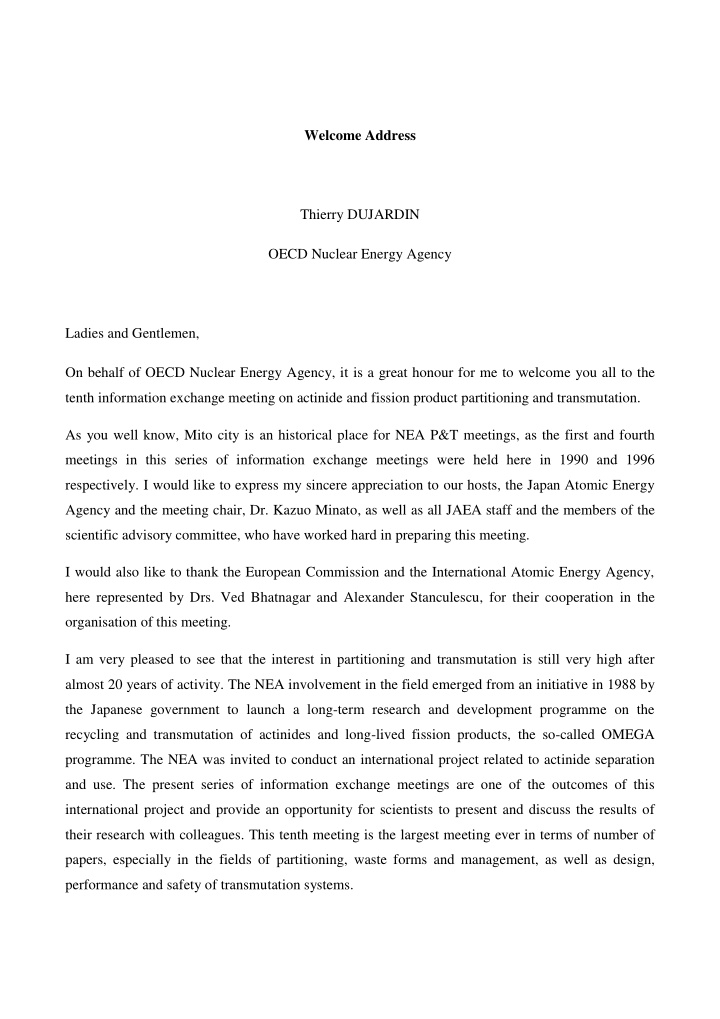



Welcome Address Thierry DUJARDIN OECD Nuclear Energy Agency Ladies and Gentlemen, On behalf of OECD Nuclear Energy Agency, it is a great honour for me to welcome you all to the tenth information exchange meeting on actinide and fission product partitioning and transmutation. As you well know, Mito city is an historical place for NEA P&T meetings, as the first and fourth meetings in this series of information exchange meetings were held here in 1990 and 1996 respectively. I would like to express my sincere appreciation to our hosts, the Japan Atomic Energy Agency and the meeting chair, Dr. Kazuo Minato, as well as all JAEA staff and the members of the scientific advisory committee, who have worked hard in preparing this meeting. I would also like to thank the European Commission and the International Atomic Energy Agency, here represented by Drs. Ved Bhatnagar and Alexander Stanculescu, for their cooperation in the organisation of this meeting. I am very pleased to see that the interest in partitioning and transmutation is still very high after almost 20 years of activity. The NEA involvement in the field emerged from an initiative in 1988 by the Japanese government to launch a long-term research and development programme on the recycling and transmutation of actinides and long-lived fission products, the so-called OMEGA programme. The NEA was invited to conduct an international project related to actinide separation and use. The present series of information exchange meetings are one of the outcomes of this international project and provide an opportunity for scientists to present and discuss the results of their research with colleagues. This tenth meeting is the largest meeting ever in terms of number of papers, especially in the fields of partitioning, waste forms and management, as well as design, performance and safety of transmutation systems.
The two NEA committees, the Nuclear Science Committee and the Nuclear Development Committee, who organise this series of meetings, have introduced a novelty at this year’s meeting. They have decided that at every second meeting there will be a special session dedicated to a specific field of research, replacing the reports on national programmes. This year ’s special session will be devoted to fuel cycle strategies and transition scenarios, a topic included in both NEA Committees programmes of work that I will briefly develop in my presentation later this morning. Recent years may be looked at as a turning point in the consideration of nuclear energy as a viable option for future sustainable energy policies. The main reasons for this nuclear comeback on the world energy agenda are well-known: rising fossil fuel prices and increasing concerns about climate change and the security of energy supply. However, there is still a gap between a comeback on the agenda and an effective and efficient role of nuclear energy in the future world energy mix. As the Generation IV International Forum stated it, future nuclear energy systems will require better economics, increased safety and reliability, enhanced resistance to proliferation, improved physical protection, a better use of natural resources and a better management of waste. In many OECD countries the latter goal is the key issue to increase public acceptance. With its potential to strongly reduce the amount and the radiotoxicity of nuclear waste ultimately disposed of, partitioning and transmutation and advanced fuel cycles offer opportunities which should be considered among future options to increase the public confidence in the safe and sustainable management of high-level radioactive waste. And at the last NEA P&T meeting, held at Nîmes, France, in September 2006, it was noted that optimisation of the fuel cycle through partitioning and transmutation must take into account waste management issues, for all waste streams within the fuel cycle, including their associated costs and risks. I would like to also take this opportunity to inform you that the 50 th anniversary of the NEA will be celebrated next week in connection with the meeting of the NEA Steering Committee. During the celebration session more than 300 dignitaries and government experts, including ministers from many countries, the OECD Secretary General and the IAEA Director General, will discuss the future of nuclear energy for peaceful purposes and challenges for new nuclear build. In connection with this anniversary the NEA will also publish a book entitled “Nuclear Energy Outlook” , a first of a kind for the NEA, aiming to respond to the renewed interest in nuclear energy by many OECD countries. It uses the most current data and statistics available and provides projections up to 2050 to consider growth scenarios and potential implications on the future use of nuclear energy. It also offers unique analysis and recommendations on the possible challenges that lie ahead
Before closing my welcome address, I am happy to announce that the NEA has received a proposal from the Idaho National Laboratory in USA to host the next information exchange meeting on P&T in the second half of 2010. The details will be announced in near future. Ladies and Gentlemen, unfortunately, I will not be able to stay with you until Thursday, but looking at the programme, I am convinced that you will have a very interesting and fruitful meeting. I wish you all a very enjoyable stay in Mito. Thank you for your attention.
Recommend
More recommend